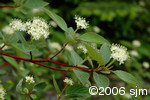
|
Northern Ontario Plant Database 
Plant DescriptionCornus stolonifera Michx.En: red osier dogwood, red willow, redstem dogwood
Cornaceae (Dogwood Family) The genus Cornus: Woody dogwood (Cornus) species are medium to tall shrubs, usually with opposite leaves and branches, except for Cornus alternifolia, which has alternate leaves. Cornus leaves are easily recognized by their pinnate, arcuate veins, which curve inward towards the tip (apex) of the leaf. For more information, read the genus description, followed by keys to the Cornus species native to Ontario. General: An erect, deciduous shrub, 2 to 3 m tall, spreading by stolons and often forming dense thickets; young twigs greenish and covered with fine hairs (finely pubescent), mature and older twigs smooth (glabrous), usually red, marked with numerous light lenticels; stems have a large white pith. Nomenclature: Until recently, the name Cornus stolonifera, described by Michaux in 1803, was applied to North American specimens of Cornus sericea. These two names have been shown to belong to the same species, C. sericea, first described by Linnaeus in 1771. Leaves: Opposite, simple, pinnately-veined, petiolate. Leaf blades ovate, to 15 cm long and 9 cm wide; dark green above, paler and finely pubescent beneath; base tapering or rounded; apex sharply pointed (acuminate); margins entire. Veins arranged in 5 to 7 pairs, arcuate (curving inward towards the apex). Flowers: Bisexual, numerous, arranged in flat-topped clusters (cymes), to 6 cm across. Calyx minute; corolla white, deeply 4-lobed; stamens 4; the single pistil has an inferior ovary, a single slender style, and small stigma terminating the style; a pale yellowish to red-tinged nectar disk surrounds the base of the style, between the stamens and the style. The style and nectar disk are persistent in fruit. Flowers bloom in early summer. Fruits: Fleshy, white drupes, spherical, to 6 mm long, each topped by a black dot, formed by the persistent darkened style and nectar disk. The several drupes are borne on dark purple stalks (pedicels) in a branched cluster. Fruits mature in late summer. Habitat and Range: Damp woods, shores, thickets, and moist to wet roadsides. Cornus sericea is a common north temperate-boreal species, distributed throughout Ontario. Internet Images: Cornus sericea, labelled as C. stolonifera, from the University of Northern British Columbia. This webpage provides numberous images of the plant at different developmental stages. Cornus sericea from the Wetland Plants of Wisconsin website, Univ. of Wisconsin - Green Bay. Similar Species: Cornus alternifolia can be distinguished by its alternate leaves and deep blue drupes, which are borne on bright red pedicels. Cornus rugosa can be distinguished by the rough texture of the upper surface of its broad leaves and its greenish-white to light blue drupes, which are also borne on bright red pedicels. written by Derek Goertz and Susan J. Meades Back to species list |
||||||||||||||||||||||










